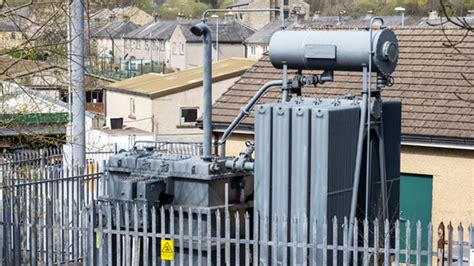
A string of unprecedented fires at eight UK electricity substations in just ten weeks has ignited concerns that years of underinvestment and neglect may pose a greater threat to the nation’s energy infrastructure than potential acts of sabotage. While authorities remain tight-lipped about the exact causes of the blazes, experts are increasingly pointing to the aging infrastructure, strained resources, and a lack of proactive maintenance as significant contributing factors to the escalating crisis.
The alarming frequency of these incidents, which have occurred across various locations in the UK, has prompted investigations by both National Grid and local fire services, but as of yet, no definitive conclusions have been publicly released. “The number of fires is concerning, and we are working with the relevant authorities to investigate,” a National Grid spokesperson stated, according to reports. The lack of transparency surrounding the investigations has fueled speculation and raised questions about the vulnerability of the UK’s power network.
The incidents have not resulted in widespread power outages thus far, but the potential for future disruptions remains a major concern. Substations play a critical role in regulating voltage and distributing electricity from power plants to homes and businesses. Damage to these facilities can lead to localized blackouts, and if a major substation is severely compromised, it could trigger wider grid instability.
The timing of these incidents is particularly worrying, given the ongoing energy crisis and the increasing reliance on electricity for heating and transportation. Any significant disruption to the power supply could have severe economic and social consequences. Furthermore, the fires have raised concerns about the safety of substation workers and the potential environmental impact of the blazes.
Adding to the complexity of the situation, the UK’s energy infrastructure is facing increasing strain from the transition to renewable energy sources. The integration of intermittent sources like wind and solar power requires significant upgrades to the grid to ensure stability and reliability. This places additional pressure on an already aging and under-maintained system.
Experts argue that a comprehensive review of the UK’s energy infrastructure is urgently needed, along with increased investment in maintenance and upgrades. Failure to address these issues could leave the country vulnerable to more frequent and severe disruptions in the future. The question remains: is the current crisis a wake-up call, or a harbinger of things to come?
The Growing List of Incidents
The recent surge in substation fires is unprecedented, according to industry experts. While isolated incidents are not uncommon, the sheer number occurring within such a short timeframe has raised serious alarms. The affected substations are located in various regions of the UK, indicating that the problem is not confined to a specific geographical area.
Details about the specific substations involved have been limited, likely due to security concerns and ongoing investigations. However, reports suggest that the incidents have involved a range of equipment, including transformers, switchgear, and cables. The causes of the fires are still under investigation, but potential factors include equipment failure, overheating, electrical faults, and external factors such as weather conditions.
One particularly concerning aspect of the incidents is the potential for cascading failures. Substations are interconnected, and damage to one facility can potentially trigger problems at others. This is particularly true in areas with limited redundancy in the grid. In the event of a major substation outage, neighboring substations may be forced to carry additional load, which can increase the risk of overheating and failure.
The fires have also raised questions about the adequacy of fire safety measures at substations. Substations typically have fire suppression systems in place, but these systems may not be sufficient to handle large-scale fires involving flammable materials such as transformer oil. Furthermore, the remote location of some substations can make it difficult for firefighters to respond quickly to emergencies.
Neglect vs. Sabotage: Weighing the Evidence
While the possibility of sabotage cannot be completely ruled out, the prevailing view among experts is that neglect and underinvestment are the more likely culprits behind the recent surge in substation fires. The UK’s energy infrastructure has suffered from years of underfunding, leading to a backlog of maintenance and upgrades. This has increased the risk of equipment failure and other problems that can lead to fires.
“We have been warning for years that the UK’s energy infrastructure is aging and in need of significant investment,” said a representative from a leading engineering consultancy. “The recent fires are a symptom of a system that is being stretched to its limits.”
One of the key areas of concern is the age of the equipment used in many substations. Some substations still rely on equipment that is decades old, and this equipment is increasingly prone to failure. Furthermore, the lack of regular maintenance and inspections can exacerbate the problem.
“Substations are like any other piece of machinery – they require regular maintenance to ensure that they are operating safely and efficiently,” said an electrical engineer with experience in substation maintenance. “If maintenance is neglected, problems can quickly develop.”
Another factor that may be contributing to the fires is the increasing strain on the grid from the transition to renewable energy sources. The integration of intermittent sources like wind and solar power requires significant upgrades to the grid to ensure stability and reliability. However, these upgrades have not always kept pace with the growth of renewable energy, leading to increased stress on existing infrastructure.
While sabotage remains a possibility, the lack of any credible claims of responsibility and the absence of any clear pattern in the incidents suggest that it is unlikely to be the primary cause. However, authorities are still investigating all possible angles, and it is important to remain vigilant.
The Economic and Social Consequences
The potential economic and social consequences of widespread power outages are significant. In addition to the direct costs of repairing damaged infrastructure, power outages can disrupt businesses, schools, and other essential services. They can also lead to losses in productivity, damage to equipment, and increased risks of accidents.
“A major power outage can have a ripple effect throughout the economy,” said an economist specializing in infrastructure. “Businesses may be forced to shut down, supply chains can be disrupted, and consumers may be unable to access essential services.”
Furthermore, power outages can disproportionately affect vulnerable populations, such as the elderly and those with medical conditions that require electricity. During extreme weather events, power outages can put people at risk of hypothermia or heatstroke.
The fires have also raised concerns about the safety of substation workers. Substations are hazardous environments, and workers are exposed to risks such as electrical shock, burns, and explosions. Ensuring the safety of these workers is paramount, and adequate safety measures must be in place to protect them from harm.
The environmental impact of substation fires is also a concern. Fires can release harmful pollutants into the air and soil, and the cleanup of contaminated sites can be costly and time-consuming. Furthermore, the loss of electricity can lead to increased reliance on fossil fuels, which can exacerbate climate change.
The Need for Action
The recent surge in substation fires has highlighted the urgent need for action to address the challenges facing the UK’s energy infrastructure. A comprehensive review of the system is needed, along with increased investment in maintenance and upgrades. This review should identify areas of weakness and develop a plan to address them.
“We need to take a hard look at our energy infrastructure and identify where we need to invest,” said a member of Parliament who sits on the Energy and Climate Change Committee. “We cannot afford to wait until a major crisis occurs before we take action.”
Increased investment in maintenance and upgrades is essential to ensure that substations are operating safely and efficiently. This investment should focus on replacing aging equipment, improving fire safety measures, and upgrading the grid to accommodate the growth of renewable energy.
“We need to prioritize maintenance and upgrades to our energy infrastructure,” said a representative from a leading engineering consultancy. “This is not a luxury – it is a necessity.”
In addition to increased investment, there is also a need for better coordination and communication between the various organizations involved in managing the UK’s energy infrastructure. This includes National Grid, local electricity distribution companies, and government agencies.
“We need to improve communication and coordination between the different players in the energy sector,” said a senior official at the Department for Energy Security and Net Zero. “This will help us to identify and address potential problems more quickly.”
Finally, it is important to raise public awareness about the importance of energy infrastructure and the need for investment. A well-informed public is more likely to support the necessary investments to ensure a reliable and affordable energy supply.
The Path Forward: Ensuring a Secure Energy Future
The UK faces a critical juncture in its energy future. The confluence of aging infrastructure, increased demand, the transition to renewable energy, and potential security threats requires a concerted and strategic response. Failure to address these challenges could lead to more frequent and severe disruptions to the power supply, with significant economic and social consequences.
The path forward requires a multi-pronged approach that includes:
- Increased Investment: A significant and sustained increase in investment in energy infrastructure is essential. This investment should focus on replacing aging equipment, upgrading the grid, improving fire safety measures, and developing new technologies.
- Proactive Maintenance: A shift from reactive to proactive maintenance is needed. This involves regular inspections, preventative maintenance, and the use of advanced technologies to detect potential problems before they occur.
- Enhanced Security: Security measures at substations and other critical energy infrastructure must be strengthened. This includes physical security, cybersecurity, and intelligence gathering to deter and prevent acts of sabotage or terrorism.
- Grid Modernization: The grid must be modernized to accommodate the growth of renewable energy sources. This includes investments in smart grids, energy storage, and demand response technologies.
- Workforce Development: A skilled workforce is essential to maintain and operate the UK’s energy infrastructure. This requires investments in training and education programs to develop the next generation of engineers, technicians, and other skilled workers.
- Public Awareness: Public awareness campaigns are needed to educate the public about the importance of energy infrastructure and the need for investment. This can help to build support for the necessary policies and funding.
- Regulatory Reform: Regulatory reforms may be needed to incentivize investment in energy infrastructure and to ensure that the system is operating efficiently and effectively.
- Emergency Preparedness: Robust emergency preparedness plans are essential to mitigate the impact of power outages and other disruptions. These plans should include procedures for restoring power quickly, providing assistance to vulnerable populations, and communicating with the public.
By taking these steps, the UK can ensure a secure, reliable, and affordable energy future for all its citizens. The recent substation fires serve as a stark reminder of the importance of investing in our energy infrastructure and taking proactive measures to protect it from threats. The time to act is now.
Frequently Asked Questions (FAQ)
- What is an electricity substation, and why are they important?
An electricity substation is a critical component of the electrical grid. It’s a facility that transforms voltage from high to low, or vice versa, to regulate and distribute electricity. Substations allow electricity to be transmitted efficiently over long distances at high voltage and then stepped down to lower voltages suitable for homes and businesses. Without substations, the electricity generated at power plants couldn’t be effectively delivered to end-users. They are essentially the nodes that ensure a consistent and reliable power supply. If a substation fails, localized or even wider-spread power outages can occur.
- What are the potential causes of the recent UK substation fires?
While investigations are ongoing, potential causes can be broadly categorized. Equipment failure due to aging infrastructure, lack of maintenance, or manufacturing defects are primary suspects. Overheating caused by increased demand or inefficient equipment operation is another possibility. Electrical faults, such as short circuits or insulation breakdown, can ignite flammable materials like transformer oil. External factors like extreme weather conditions, such as heat waves or lightning strikes, can also contribute. Although less likely, the possibility of sabotage or deliberate acts of arson is being considered.
- How could these substation fires impact the average citizen in the UK?
The immediate impact could be localized power outages affecting homes, businesses, and essential services like hospitals and schools. Longer-term, repeated incidents could undermine confidence in the reliability of the electricity supply. This could lead to increased costs for businesses, potential disruptions to daily life, and anxieties around energy security, especially during peak demand periods like winter. Widespread or prolonged outages could also affect critical infrastructure, such as transportation and communication networks. The cumulative effect could be substantial economic and social disruption.
- What measures are being taken to investigate the fires and prevent future incidents?
National Grid and local fire services are conducting investigations to determine the causes of each fire. These investigations likely involve forensic analysis of equipment, examination of maintenance records, and assessment of security protocols. National Grid is also reviewing its overall maintenance strategy and emergency response procedures. Preventative measures could include accelerated replacement of aging equipment, increased frequency of inspections and maintenance, upgrades to fire suppression systems, enhanced security measures at substations, and investments in grid modernization to improve resilience.
- What is the government doing to address the broader issue of aging energy infrastructure in the UK?
The government has acknowledged the need for investment in energy infrastructure and has set targets for renewable energy generation, which necessitate grid upgrades. However, concerns remain about the pace of investment and the effectiveness of current policies. The government could implement measures such as providing financial incentives for infrastructure upgrades, streamlining the regulatory process for new projects, increasing funding for research and development in grid technologies, and establishing stricter standards for substation maintenance and safety. Greater transparency and public accountability in infrastructure planning and spending are also crucial.
- Are the substation fires linked to the increasing adoption of renewable energy sources?
Indirectly, yes. The increasing integration of intermittent renewable energy sources like wind and solar power places additional strain on the existing grid infrastructure. The grid was originally designed for centralized power generation and doesn’t always handle the fluctuating output of renewables efficiently. This necessitates upgrades to improve grid stability and flexibility. If these upgrades lag behind the growth of renewable energy capacity, it can exacerbate the problems associated with aging infrastructure and increase the risk of equipment failure. Therefore, while renewable energy is not the direct cause of the fires, it amplifies the need for investment and modernization.
- What kind of security measures are typically in place at electricity substations?
Security measures at electricity substations vary but often include perimeter fencing, security cameras, alarm systems, and controlled access points. Some substations may also have on-site security personnel. Cybersecurity is also a growing concern, with measures in place to protect against cyberattacks that could disrupt substation operations or compromise grid control systems. However, the effectiveness of these measures can vary, and some substations may be more vulnerable than others. Regular security assessments and upgrades are essential to stay ahead of potential threats.
- How does the age of UK’s energy infrastructure compare to that of other developed countries?
The UK’s energy infrastructure is generally considered to be older than that of some other developed countries, particularly those that have made more recent investments in grid modernization. Many substations in the UK still rely on equipment that was installed decades ago, and the lack of consistent investment has led to a backlog of maintenance and upgrades. This puts the UK at a disadvantage compared to countries that have proactively modernized their grids to improve reliability and resilience.
- What is the role of National Grid in maintaining and upgrading the UK’s electricity substations?
National Grid owns and operates the high-voltage transmission network in the UK, which includes many of the country’s largest electricity substations. National Grid is responsible for maintaining and upgrading this network to ensure a reliable and secure electricity supply. This includes carrying out regular inspections, performing preventative maintenance, and investing in new equipment and technologies. National Grid also works with local electricity distribution companies to coordinate grid operations and respond to emergencies.
- What are some potential long-term solutions to prevent future substation fires and improve energy security?
Long-term solutions include: aggressive infrastructure investment with a focus on preventative maintenance and equipment replacement, diversifying energy sources to reduce reliance on a single type, accelerating the deployment of smart grid technologies for better monitoring and control, strengthening cybersecurity protocols to protect against cyberattacks, implementing stricter regulatory standards for substation safety and maintenance, promoting energy efficiency to reduce overall demand, investing in energy storage solutions to improve grid stability, and fostering greater public awareness about energy infrastructure and security. A comprehensive and sustained effort across all these areas is needed to ensure a reliable and secure energy future for the UK.









